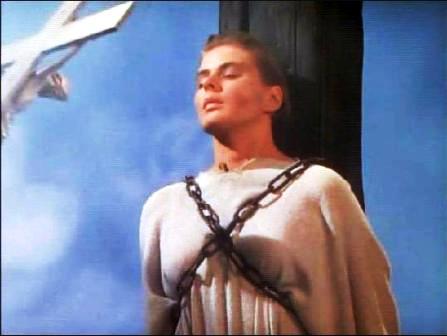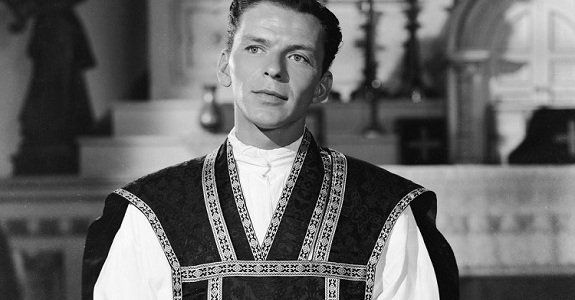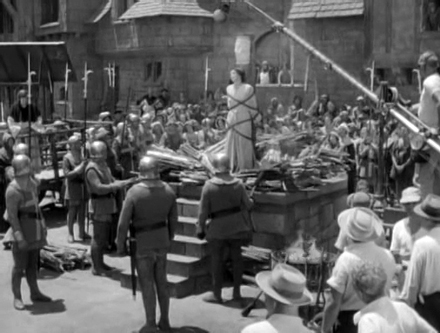TCM has a Joan of Arc movie marathon going! I think St. Joan of Arc is a great example for young people, girls and boys alike.
 Have you ever read Mark Twain’s superb novel about St. Joan? He thought it was his best work.
Have you ever read Mark Twain’s superb novel about St. Joan? He thought it was his best work.
Tonight they had:
1948 – Joan of Arc with Ingrid Bergman – too bad it was so … pretty, and then there was that scandal. Jose Ferrer = loathsome.



It was idealized, but it was Catholic. Joan was taken seriously and was portrayed as godly and not… well.. nuts. It was a different era, to be sure. And people of the time cared so much for morality even in the actors and actresses that the film failed in its day at the box office.
1957 – Saint Joan based on Shaw’s play – I had forgotten how pernicious it really is, but Richard Widmark? Really? Did you know he was born in Minnesota?




There was a hilarious anachronistic moment after the coronation when they included in soundtrack a fugue from the end of a Gloria of a Haydn Mass. This was as bad as the 19th c. style anthem sung after the battle in Branagh’s Henry V. Preminger works in a Te Deum, again! Clever script with little jokes for the well-read. But this is a pernicious film. Constant reduction of the supernatural to the natural. George Bernard Shaw. Dumbed-down Shaw for a screen-play. But dumbed-down and made contemporary and slick by Graham Greene! But Widmark was fun… and with John Gielgud to boot! Panned. Not well received. I’m glad Preminger failed.
 1928 – The Passion of Joan of Arc – just a few years after her canonization, the great silent film which barely survived destruction, new with new/old music by Richard Einhorn sung by Anonymous 4.
1928 – The Passion of Joan of Arc – just a few years after her canonization, the great silent film which barely survived destruction, new with new/old music by Richard Einhorn sung by Anonymous 4.
Gripping doesn’t do it justice.

1962 – Le Proces de Jeanne d’Arc – haven’t seen this one. Based on trial records.
ADDENDUM:
Honorable mention goes to The Miracle of the Bells with Frank Sinatra as a priest and Fred MacMurray. Frank sings in Polish and Fred helps a fated woman get cast in a movie as St. Joan. 1948.


































“Dumbed down” is a mild description of what Preminger did to Shaw’s play. GB Shaw was a skeptic, to be sure, but his stage version is always smart, often fascinating, and allows for the supernatural to be a possibility. One of the most notable aspect of his polemical plays is that he gives each side of an argument a scrupulously fair hearing, with no straw men. The trial scene might amuse, or irritate, or even madden us who believe– but it also sparks some useful, if uncomfortable, thought. The film boils all that down to jokes and disbelief.
I’m hoping I can stay awake for The Passion of Joan of Arc. Anonymous 4!
The 1962 Bresson film is excellent, though very different in approach to the superb 1928 Dreyer work. Both are highly recommended!
Florence King, the Southern writer, struggled to define a ‘good old boy’ and the truly grand gesture they were sometimes capable of. Going deep into her Anglo-Saxon roots she gives as her example: the anonymous lout of an illiterate English common soldier (probably a thief, rapist and murderer as a matter of course ) who tied two sticks together from her pyre to make a cross for Jean to hold.
The 1928 film is astoundingly good! It came on TCM late one night a few years ago and my Mom and I were unable to look away.
I’ve actually been meaning to read the Twain book; I’ve been pondering St. Joan a lot lately. Why was her canonization so late? Some say it was a political move to bolster France after WWI. Also, why did God choose her to intervene in this one European conflict? Goodness knows France and England would fight another day, and that takeovers of other nations were frequent in European history. Did St. Catherine of Alexandria have a particular interest in choosing sides in this fight?
Oh well, visions of saints are a mercurial thing. I’ll just have to wait until I get to heaven for Divine Providence to fully make sense.
Sarah L– those interested in St Joan and her role in the French-English conflict might be interested in Shakespeare’s rarely performed Henry VI, part 1, in which Joan is a villainess! To the English of Shakespeare’s time she was still regarded as a sorceress, and he presents her very unsympathetically. No films of that one, I think!
I’m assuming the scandal with the 1948 version has something to do with Rossellini, but then I don’t understand why Jose Ferrer is loathsome. I’m curious what the story is, and not because I’m particularly interested in tabloid type celebrity gossip, but simply because it was mentioned and then not explained. That sort of thing drives me bonkers. It’s a Pandora’s box thing for me.
Henry VI, Part I is filmed as part of the BBC Shakespeare set (which is a great deal, if you can play European DVDs). According to Wikipedia, it’s also in the BBC’s “An Age of Kings”.
I was able to see the 1928 version at a theater that was showing it which gave the benefit of seeing the movie on the big screen plus having the theater sound system for the soundtrack that had been made. It was amazing. Without words it so conveyed the faith of Joan and the mission from God that she took on even though it was so outside her experience, and how much she was let down by those in power who should have been listening to the message they were being given.
There was another silent one called “Joan the Woman,” from around 1916. It’s been a while since I’ve seen it, but I remember it was quite reverent. They did understandably play up the patriotic angle due to the War going on at that time.
Such an awesome reminder of the what the SSPX would take us back to. [Burning holy young women alive in the public square?]
Mark Twain’s book on St Joan of Arc is amazing!!!! Which of the movies is the best to watch?
The 1928 version is on YouTube: http://www.youtube.com/watch?v=VH40DEzUXdE and elsewhere, I’m sure.
AMDG,
I have Mark Twain’s book, and tapes of Ingrid Bergman’s ‘Joan of Arc’ and ‘The Passion of Joan of Arc’. I also have the CD of Richard Einhorn’s ‘Voices of Light’.
I remember watching ‘Saint Joan’ in 1966, before my Confirmation. I began to learn about St. Joan in my sixth-grade history class, and after I did, I was ‘hooked’ on her! That still of the burning of Jean Seberg as Joan is ‘scarifying’!
I’ve also been to the three places in France connected with St. Joan: Domremy (her birthplace), Orleans (site of her great military victory) and Rouen (site of her trial and burning)-my first visit to France in 1985 was a St. Joan pilgrimage. It timed it to attend the annual ‘Fete de Jeanne d’Arc’ in Orleans.
When I visited the “House of Joan of Arc’ in Orleans in 2000, I saw a wall display showing a time line of all the existing Joan of Arc films. It was dominated by a huge photo of Renee Falconetti-star of ‘The Passion of Joan of Arc’ (you can’t forget those huge glowing eyes of hers!)-embracing the crucifix before being bound to the stake.
digdigby-I have sometimes wondered what happened to that unnamed English soldier who made the little cross for Joan before her death. Did she intercede with Our Lord for him after she entered heaven? Did she meet him at the gate of heaven to thank him for that kind gesture?
This ‘movie marathon’ sounds really cool! I know that 2011 is the 580th anniversary of her death at Rouen-is that the reason it was done?
irishgirl –
-I have sometimes wondered what happened to that unnamed English soldier who made the little cross for Joan before her death. Did she intercede with Our Lord for him after she entered heaven? Did she meet him at the gate of heaven to thank him for that kind gesture?
Little Therese as a girl prayed along with her sister for salvation for an astonishingly brutal murderer of an entire family who was about to be guillotined and kept refusing priestly attention.
At the last moment, this ‘monster’ shoved away the priest, grabbed the crucifix and fiercely embraced and kissed the crucified Christ. Therese was satisfied that her prayers for his salvation were answered. I understand, these days, we must sometimes (at least figuratively) “push away the priest” and grab the crucifix, especially if the priest is an effeminate Marxist dressed like a rainbow.
digdigby-I don’t know if Pranzini ‘pushed away the priest’ at the moment of his execution to kiss the crucifix. I know that he called for it, and then he kissed it.
What do you mean by, ‘we must sometimes (at least figuratively) ‘push away the priest’ and grab the crucifix, especially if the priest is an effeminate Marxist dressed like a rainbow’?
St. Joan certainly didn’t ‘push away the priest’ when the crucifix was offered her at her death! She asked him for it, and he brought it to her. She only begged him to get down and away from the stake once the fire was lighted, so that he wouldn’t get burned himself, but that he hold the crucifix up before her eyes that she might fix her gaze on it when the pain became too much for her to endure. Remember that her last word was ‘JESUS!’
When I’ve watched the video I have of ‘The Passion of Joan of Arc’, I always say, ‘Look at the crucifix!’ at the final scene when the burning takes place.
Legisperitus-I’ve seen “Joan the Woman’, too. Geraldine Farrar plays St. Joan in that one. Was that directed by Cecil B. DeMille, by any chance? I viewed this at the home of a woman in Albuquerque, New Mexico, who has a website dedicated to St. Joan. She has a little museum of Joan of Arc items in a spare room of her house. I nearly cried out at the burning! That was hard to watch!
Unless I miss the mark, I believe Father Z is referring to Jose Ferrer’s character as loathsome. He was a brilliant actor.
Jacob-I’m thinking the same thing. Jose Ferrer was brilliant as Charles VII-in fact, ‘Joan of Arc’ was his film debut. He even looked like the ‘original’ Dauphin, if you’ve seen the portrait by Fouquet in the Louvre.
Charles VII was called ‘The Victorious’, but he was a loathsome rat in deserting St. Joan when she was captured and imprisoned by the English and their Burgundian allies. He wouldn’t even allow any of her comrades-in-arms (Dunois, Alencon LaHire) to attempt a rescue of her from prison.
Of course, he ‘made up for it’ by instigating the Process of Rehabilitation to clear St. Joan’s name. And it helped that her Mama, Isabelle Romee, was alive to push it through! A tenacious and valiant mother, just like her daughter!
Irishgirl – Yes, that was a Cecil B!
I actually portrayed the Dauphin in our little semi-pro troupe’s production of Shaw’s “Saint Joan.” I saw the 1957 movie a few years later, and was surprised to see that I (with my limited third-rate acting ability) was able to stumble upon the same approach Richard Widmark solidly nailed in his portrayal.
As noted above, Shaw’s play presented all sides of the arguments, in great expository detail (which we had to compress to make the play watchable–and performable for us!), and although Shaw was glad to recast the the struggle over Joan in terms of a secular new-verus-old order perspective (the new “nationalism” as a “secular heresy” to the old feudal model), as well as to portray the Church and its officials as hypocrytical and disbelieving, the possibility of the supernatural was never sucessfully debunked within the play itself–the arguments put forth by the royal court as to how Joan did what she did fell REALLY flat, and were possibly intentionally made at way by the playwright himself.
So, although Shaw’s play is pernicious, I did not think that it was very convincing in terms of de-sacralizing the Saint herself.
Michael Val
(who did a lot of classical theater in his crazier days)
I should have put a comma in my parenthesis (Dunois, Alencon, LaHire). That’s what happens when you use a different computer keyboard….sigh…
Legisperitus-I’m glad to know I was right about ‘Cecil B’ [DeMille] being the director of ‘Joan The Woman’. Well, if he could do two films on Moses-‘The Ten Commandments’-he could certainly attempt a movie about St. Joan!
One of the lines I remember from Shaw’s ‘Saint Joan’ was in the Epilogue when she appears to Charles years after her death: ‘Well, I got to go now, Charlie’, and he turns over in his bed and says: ‘Goom-bye’ [or else it was ‘Goo-night’]. It’s stuck in my mind after all these years….thought it sounded so funny….
Regarding Mark Twain’s book on St. Joan: he said it was ‘the best of all my books’. He spent twelve years doing research in France. And his severest critic while he wrote it was his wife Olivia-she’d give him a certain ‘look’ when she didn’t like what he wrote!
I hope that she was there to greet him at the end of his life on earth.
(Yeah, I know I’m doing ‘multiple comments’ on this entry, Father Z-but I can’t help it-St. Joan is one of my favorite Saints! I can’t saying something about her!)
Do any of the films correctly depict the saint as having begged for a crucifix to look upon as she burned i.e. a crucifix, if present at all, didn’t just happen to be there?
Brad: yes